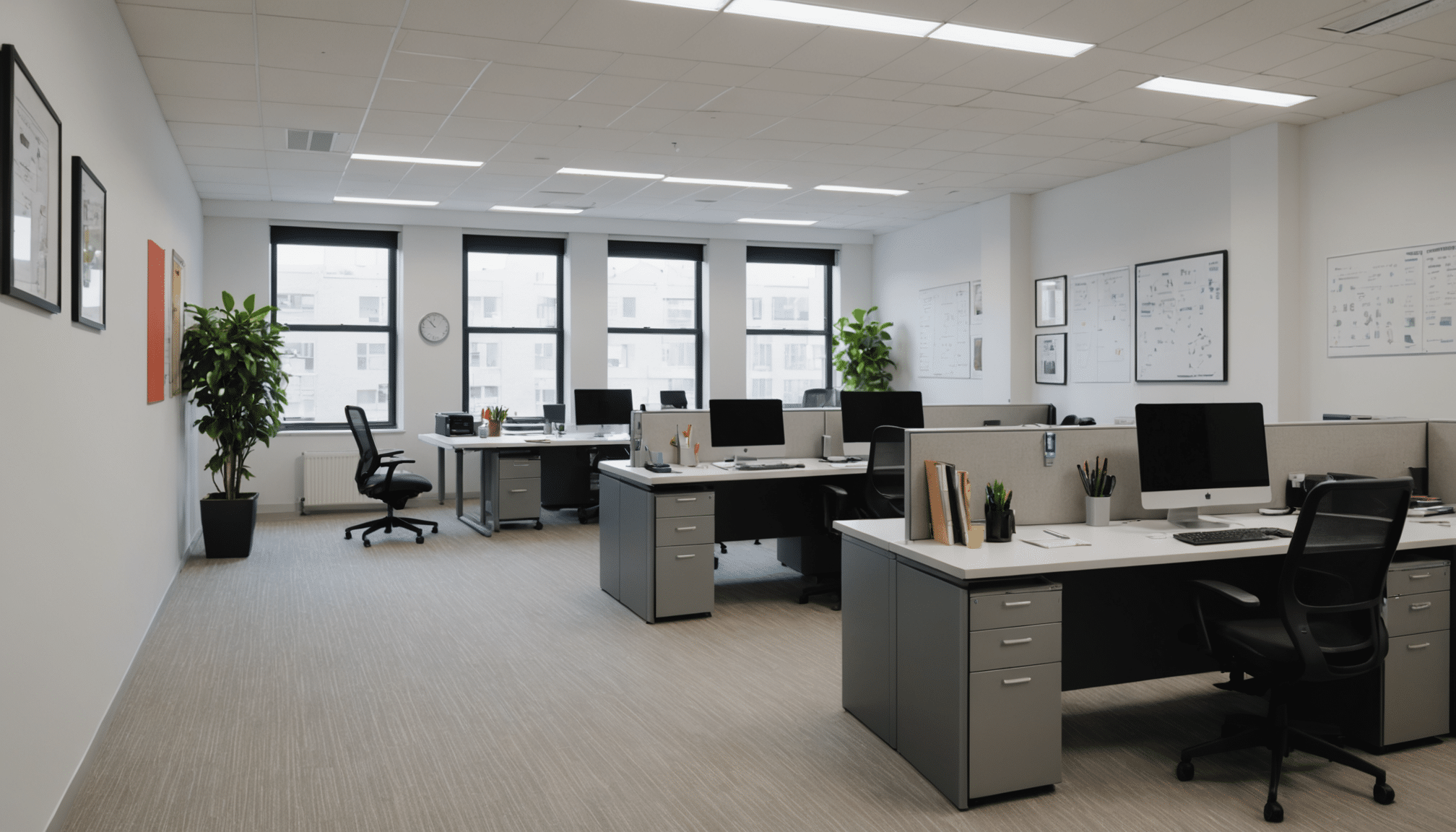
What do you need to set up an office?
Starting a business can be challening. Here's a checklist to set up an office including advice on office supplies.
Last Updated on 25/11/2025
Setting up an office—whether at home or for a business—starts with clear planning. This guide outlines what you need, from key office equipment to designing a floor plan. Use it as a practical starting point to shape your workspace and make informed decisions before you invest in anything.
What do I need to set up an office?
You need a desk, chair, computer, reliable internet, printer, stationery, storage like filing cabinets, and basic furniture. Consider layout, lighting, communication tools, and a clear budget. Whether for a home office or new workspace, start with a checklist to cover all essentials before making any purchases.
Key Items for Office Setup Success
- Start with a good desk and ergonomic chair for comfort and productivity.
- Secure fast, reliable internet and the right computer for daily tasks.
- Include a printer, basic stationery, and storage like a filing cabinet.
- Plan your layout to optimise space, light, and movement between zones.
- Consider communication tools: telephone, voicemail, and email systems.
- Use digital tools to manage your budget and visualise the floor plan.
- Add extras like a microwave or fridge to boost convenience during the day.
New Office Checklist Essentials
Before you fill your office space with furniture and gadgets, it helps to start with a clear checklist. Begin with the basics: a good desk and an ergonomic chair are the bread and butter of any setup. You’ll also need essentials like a computer or laptop, a printer, and reliable internet. Tick off your stationery needs too – paper, pens, and maybe a trusty stapler that won’t go missing after two days.
Don’t forget the supporting cast. Filing cabinets, desk drawers, a telephone or Voice over IP setup, and a place for the photocopier matter just as much. For those using a home office, consider space-saving furniture that doesn’t compromise on comfort. A microwave or mini fridge for quick lunches? Very civilised. Add these to your new office checklist and thank yourself later.
This stage is all about function. Think of your checklist as your best mate, keeping you from forgetting the paper for the printer or the one pencil everyone ends up fighting over. You can always upgrade your office furniture later, but you need your foundations in place to keep your office humming from day one.
| Feature | Description | Importance |
|---|---|---|
| Ergonomic Desk and Chair | Provides comfort and supports posture for long working hours. | High |
| Reliable Internet Connection | Ensures smooth communication, file access, and online collaboration. | High |
| Printer and Stationery | Supports essential office tasks like document handling and note-taking. | Medium |
| Filing Cabinet | Keeps physical documents organised and easily accessible. | Medium |
| Microwave or Mini Fridge | Adds convenience for meals and drinks during work hours. | Low |

Viking Malaga Executive Chair Basic Tilt Bonded leather Fixed Armrest Height-Adjustable Seat Black 110 kg

Viking Realspace Premium Chair Mat PC (Polycarbonate) Rectangular with Lip Transparent 120 x 90 cm Soft Floor

Viking Realspace Mosil Office Chair Basic Tilt Mesh Fixed Armrest Height-Adjustable Seat Black 110 kg
Design the Floor Plan First
A clever floor plan saves time, space, and your sanity. Whether you’re fitting out an open plan room or carving out space for cubicles, how you design the layout matters. Start by measuring the office space and plotting where each piece of furniture will go. Your desk doesn’t belong in a dark corner next to the dishwasher unless you enjoy chaos with your coffee.
Think about movement and communication. Place shared resources like the printer, photocopier, and fax in central locations. Arrange desks to allow both privacy and collaboration. If you’re in the UK, space might be tight—every millimetre counts. A well-planned floor plan also supports better concentration and fewer chair collisions during rush hour (aka lunchtime).
Use layout planning tools or even just good old pencil and paper. Sketch the zones: workstations, meeting areas, break zones, and filing systems. And don’t forget to plan around sockets, windows, and landline connections. A thoughtful layout means fewer regrets—and less swearing—when the furniture arrives.
Register, Budget, and Set Up a Business
Once your layout is sorted and your checklist is coming together, it’s time to handle the paperwork. If you’re starting from scratch, you’ll need to register your company with HMRC and choose a structure—sole proprietorship, limited company, or something in between. Don’t skip this step; legal liability is not the kind of surprise anyone enjoys.
Next up: budgeting. Office equipment, furniture, software, and utility bills all add up fast. Factor in one-off purchases and ongoing costs like stationery, internet, and coffee. If you’re setting up a home office, consider how this affects your household bills. Create a clear budget now to avoid awkward calls to credit providers later.
Finally, plan your communication essentials. Think phone lines, voicemail, email accounts, and even automated attendant features if needed. It’s not just about setting up desks—it’s setting up a system. From your company’s brand to the filing cabinet labels, every detail adds polish and professionalism to your workspace. The small stuff? That’s what makes it work.
Make This Page Useful With Digital Tools
Let’s face it, planning your new office doesn’t have to mean drowning in sticky notes. There are heaps of digital tools that can save you time and grey hairs. Use online layout planners to map out your office space, or budget apps to track spend right down to the last pencil. Project management tools can also help you stay organised and on deadline.
Want to avoid endless emails? Set up shared drives, cloud calendars, and group chats. These tools streamline team communication and reduce confusion. And if your team is remote or hybrid, software like Voice over IP and call waiting features become even more important. A decent setup now means fewer headaches once work kicks off.
Need more than just ideas? Start exploring some useful office supplies to fill those digital plans with real items. Whether you’re furnishing a home office or kitting out a team in an open-plan space, these tools turn planning into doing. Make your list, check it twice, and let tech do the heavy lifting.
Conclusion
Setting up an office doesn’t need to be overwhelming. With a solid checklist, smart layout choices, and the right office essentials, you can build a workspace that supports your goals—whether it’s a home office or a new business environment.
At Viking, we’re passionate about helping you create your ideal office space. From cost-effective furniture to smart productivity tools, our solutions are designed to suit your needs and support a more sustainable workplace. Let’s make your setup work harder for you.
Frequently Asked Questions
What should be on my office setup checklist?
Your office setup checklist should include essential furniture like a desk and chair, key office equipment such as a computer, printer, and telephone, and supplies like stationery and paper. Don’t forget reliable internet, storage like a filing cabinet, and a floor plan to ensure your office space is functional and well-organised from day one.
How do I plan the layout of my new office?
Start by measuring your office space and identifying zones for workstations, storage, and shared areas. A good layout supports concentration and communication. Position desks near power outlets, keep shared tools like the printer or photocopier accessible, and allow for privacy. Planning your floor plan in advance saves time and makes your new office more productive.
What is the best desk setup for a home office?
A good home office desk setup includes a comfortable chair, a sturdy desk, and essential tools like a laptop, internet connection, and basic stationery. Prioritise natural light, reduce distractions, and ensure there’s enough space for a printer or filing drawer. The goal is to create a functional office space that supports daily tasks.
Should I include a refrigerator or microwave in my office?
If space and budget allow, a small refrigerator or microwave can improve convenience and productivity in the office. These appliances support easy lunches and drinks without needing to leave the building. Especially in an open plan or shared office space, they contribute to a more comfortable and self-sufficient work environment.






